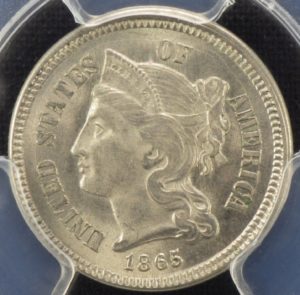Three Cent Nickels (1865-1889)
Also known as the copper-nickel-three-cent piece or three-cent nickel piece, the three cent nickels are one of the US coins with a brief part in mintage history. It was only minted for 24 years before it was discontinued.
The good news is 12 of those 24 different dates are considered rare and more valuable which spells good news to coin collectors. What is even better is that the difference in value between rare and common dates is very significant.
From 1865 to 1889, the United States Bureau of the Mint struck the three cent nickels. The coins gained popularity during its early years, with over 11 million minted when it debuted in 1865 and nearly five million the following year.
This popularity is largely due to the fact that the public preferred the three-cent nickel piece over small bronze coins and more over paper money. Unfortunately, the introduction of the five-cent copper-nickel piece caused a decrease in the popularity of the three cent nickels. The year 1873 to 1890 marked the decline and end of the coin series.
Mint Director James Pollock only saw the three-cent nickel piece as a substitute for the silver three-cent piece. This is why the coins were never intended to be a permanent part of the US coinage system. But it was only when the postal rates changed that the need for a 3 cent coin became clear—it was no longer needed. By the Act of September 26, 1890, the denomination was discontinued.
It was US Mint Chief Engraver James B. Longacre who designed the 3 cent nickel. It featured the head of Liberty wearing a beaded coronet and facing left. LIBERTY was inscribed on the coronet, while the date and UNITED STATES OF AMERICA were inscribed on the coin’s periphery.
The reverse side, on the other hand, showed the Roman Numeral III set in the center and surrounded by a wreath. The Roman numeral signified the denomination, while the laurel wreath is an adaptation of the same design found on the 1859 copper-nickel cent.
Longacre wasn’t exactly known for being imaginative in creating allegorical figures which explains why the head of Liberty is kept simple. The design on the three cent nickels is considered safe. But he was lauded for his flair for creating the hair ornamentation and wreaths.
The production of the copper-nickel-three-cent piece was all done at the Philadelphia Mint between 1865 and 1889 and yielded a total of 31,378,826 coins. For the entire 24 years, the design of the coin remained unchanged.
As a collector’s item, three cent nickels are more valuable if they are in extremely fine condition. One way to differentiate a coin between a good and very good condition is through a distinct rim. As for identifying a coin in fine condition, take a good look at the hair on Liberty’s forehead and the wreath on the reverse side.
Out of the 24 years that the three cent nickels were in production, 12 of those dates are considered common by collectors while the rest are more valuable. But the rare dates are 1882, 1883, 1884, 1885, and 1887.
